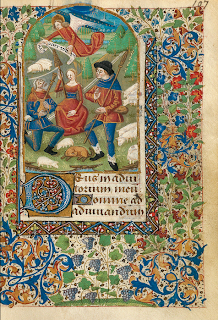Lesson Two
Seven Elements of ART
SHAPE
( We have done Line and this week we are doing Shape.)
( We have done Line and this week we are doing Shape.)
When contemplating shapes and all the many times I have taught shape to younger students, it consisted of drawings of three shapes and creating a composition with it.
For the example I chose a rectangle, a circle and a triangle. You can see there are endless combinations for those three objects, but the key is training your eye for composition and what really works with balance to the eye. There are also other factors, is the surface a square, a rectangle horizontal or vertical?
Going a little bit further sharing some ideas that are more fun, and maybe this week I would have time to explore it too... is the idea of creating a mandala. Originally Hinduism/Buddism, Mandalas have come down through the centuries as part of our art, with many parts filtering into all faiths.
Painted 17th Century Tibetan "Five Deity Mandala
Wikipedia http://en.wikipedia.org/wiki/Mandala
Mandala (Sanskrit: मण्डल Maṇḍala, 'circle') is a spiritual and ritual symbol in Hinduism and Buddhism, representing the Universe. The basic form of most mandalas is a square with four gates containing a circle with a center point. Each gate is in the general shape of a T. Mandalas often exhibit radial balance. The term is of Hindu origin. It appears in the Rig Veda as the name of the sections of the work, but is also used in other Indian religions, particularly Buddhism. In various spiritual traditions, mandalas may be employed for focusing attention of aspirants and adepts, as a spiritual teaching tool, for establishing a sacred space, and as an aid to meditation and trance induction. In common use, mandala has become a generic term for any plan, chart or geometric pattern that represents the cosmos metaphysically or symbolically; a microcosm of the universe.
Why Mandalas? They use shape to create the art... reflecting shapes that leave balance to the soul and the eye.
In my art classes we study the Book of Hours for a six week period, delving into the history and the creation of our individual pages for our own Book of Hours, a prayer book.
You can see in the repeating shapes and design the similarities to the Mandalas using repeating shapes and patterns.
As I mentioned, the Celtic Cross is another example of the designs used from the Mandalas, as well as the Rose Windows found in many Christian churches.

Why Mandalas? They use shape to create the art... reflecting shapes that leave balance to the soul and the eye.
So as you do your shape studies this week, you might want to try a Mandala.
I found this wonderful blog of Mandalas to color.
http://coloringmandalas.blogspot.com/

I also found many samples on YouTube but my favorite was this one. Enjoy your week and think of all the different things to do with shape this week. Keep it simple and have fun.
Laurie Pace
Pace Studio
Graphics One Design
GALLERY LINKS







Comments